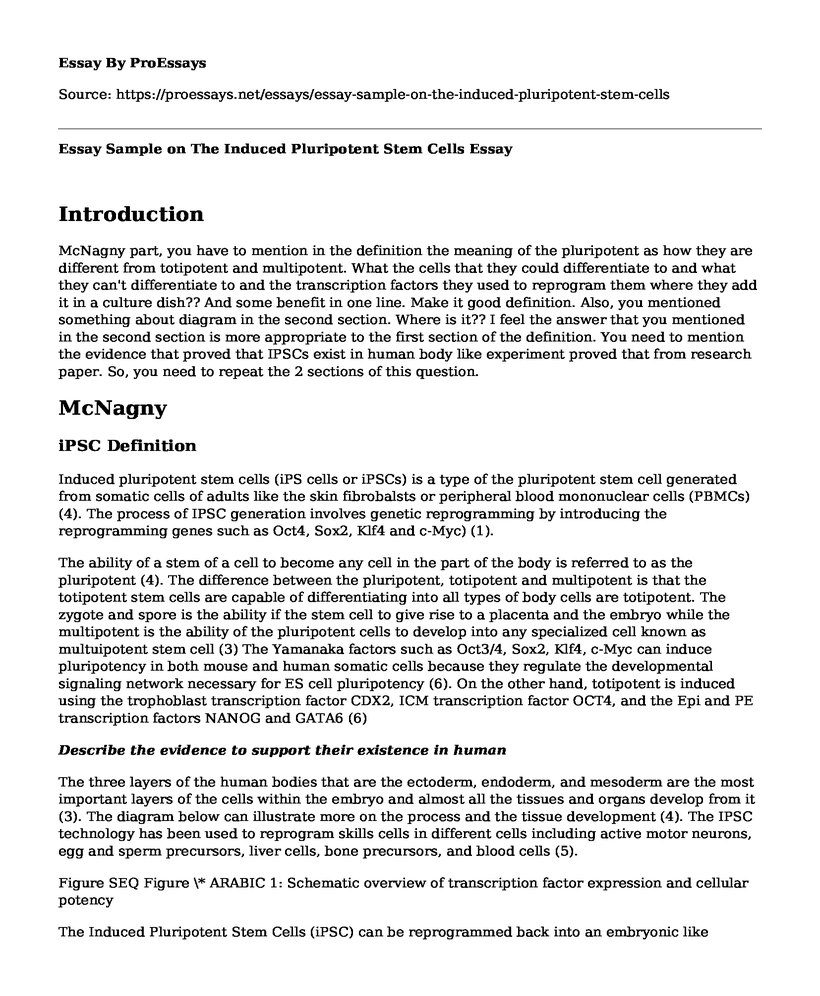Introduction
McNagny part, you have to mention in the definition the meaning of the pluripotent as how they are different from totipotent and multipotent. What the cells that they could differentiate to and what they can't differentiate to and the transcription factors they used to reprogram them where they add it in a culture dish?? And some benefit in one line. Make it good definition. Also, you mentioned something about diagram in the second section. Where is it?? I feel the answer that you mentioned in the second section is more appropriate to the first section of the definition. You need to mention the evidence that proved that IPSCs exist in human body like experiment proved that from research paper. So, you need to repeat the 2 sections of this question.
McNagny
iPSC Definition
Induced pluripotent stem cells (iPS cells or iPSCs) is a type of the pluripotent stem cell generated from somatic cells of adults like the skin fibrobalsts or peripheral blood mononuclear cells (PBMCs) (4). The process of IPSC generation involves genetic reprogramming by introducing the reprogramming genes such as Oct4, Sox2, Klf4 and c-Myc) (1).
The ability of a stem of a cell to become any cell in the part of the body is referred to as the pluripotent (4). The difference between the pluripotent, totipotent and multipotent is that the totipotent stem cells are capable of differentiating into all types of body cells are totipotent. The zygote and spore is the ability if the stem cell to give rise to a placenta and the embryo while the multipotent is the ability of the pluripotent cells to develop into any specialized cell known as multuipotent stem cell (3) The Yamanaka factors such as Oct3/4, Sox2, Klf4, c-Myc can induce pluripotency in both mouse and human somatic cells because they regulate the developmental signaling network necessary for ES cell pluripotency (6). On the other hand, totipotent is induced using the trophoblast transcription factor CDX2, ICM transcription factor OCT4, and the Epi and PE transcription factors NANOG and GATA6 (6)
Describe the evidence to support their existence in human
The three layers of the human bodies that are the ectoderm, endoderm, and mesoderm are the most important layers of the cells within the embryo and almost all the tissues and organs develop from it (3). The diagram below can illustrate more on the process and the tissue development (4). The IPSC technology has been used to reprogram skills cells in different cells including active motor neurons, egg and sperm precursors, liver cells, bone precursors, and blood cells (5).
Figure SEQ Figure \* ARABIC 1: Schematic overview of transcription factor expression and cellular potency
The Induced Pluripotent Stem Cells (iPSC) can be reprogrammed back into an embryonic like pluripotent state to enables the development of human cells needed for therapeutic purposes (2). The production of the IPSC from the somatic cells proved that adult mammalian cells could easily be redesigned to a pluripotent states using an enforced expression of selected embryonic transcription factor and influence epigenetic conformation as well as the differentiation potential of different cells at the reprogramming stages and development (3). In cell therapy, the technology has also evidently improved disease- specific stem cell derivation to treat degenerative disorders with autologous cell (7). Patients with various diseases such as ALS, Rett Syndrome, Lesch-Nyhan Disease, and Duchenne's muscular dystrophy that are considered untreatable have provided their skin cells to be used for reprogramming research to be used for developing new treatment technologies (4).
The researchers who generated the first human IPSC managed to compare the IPSC and the human ESC and differentiated the neurons and glia cells (8). The results proved that both IPSC and ESC follow similar stages and time thought the differentiation process (9). There are also experimental evidence that prove that individual IPSC lines are epigenetically unique (7)
References
Stadtfeld M, Hochedlinger K. Induced pluripotency: history, mechanisms, and applications. Genes & Development. 2010;24(20):2239-2263.
Malik N, Rao M. A Review of the Methods for Human iPSC Derivation. Methods in Molecular Biology. 2013;:23-33.
Csete M. Translational prospects for human induced pluripotent stem cells. Regenerative Medicine. 2010;5(4):509-519.
Brick R, Sun A, Tuan R. Neurotrophically Induced Mesenchymal Progenitor Cells Derived from Induced Pluripotent Stem Cells Enhance Neuritogenesis via Neurotrophin and Cytokine Production. STEM CELLS Translational Medicine. 2017;7(1):45-58.
Hu K. All Roads Lead to Induced Pluripotent Stem Cells: The Technologies of iPSC Generation. Stem Cells and Development. 2014;23(12):1285-1300.
Morgani, S. M., & Brickman, J. M. (2014). The molecular underpinnings of totipotency. Philosophical transactions of the Royal Society of London. Series B, Biological sciences, 369(1657), 20130549.
Wernig M, Meissner A, Cassady JP, Jaenisch R. c-Myc is dispensable for direct reprogramming of mouse fibroblasts. Cell Stem Cell. 2008;2:10-12
Kim JB, Greber B, Arauzo Bravo MJ, et al. Direct reprogramming of human neural stem cells by Oct4. Nature. 2009;461:649-653.
Sommer CA, Stadtfeld M, Murphy GJ, Hochedlinger K, Kotton DN, Mostoslavsky G. Induced pluripotent stem cell generation using a single lentiviral stem cell cassette. Stem Cells. 2009;27:543-549.
Cite this page
Essay Sample on The Induced Pluripotent Stem Cells. (2022, Nov 05). Retrieved from https://proessays.net/essays/essay-sample-on-the-induced-pluripotent-stem-cells
If you are the original author of this essay and no longer wish to have it published on the ProEssays website, please click below to request its removal:
- Lab Report Example on Atmospheric Properties
- Human Long Bone, Compact and Spongy Bone Paper Example
- Dynamic Earth - Essay Sample
- Safety of Genetically Engineered Food Crops - Research Paper
- History of Numbers and Counting Essay Example
- Research Paper on Bats & Viruses: The Spillover Effect & Coronavirus
- Free Essay Sample on Natural Capital: Essential for Human Survival







